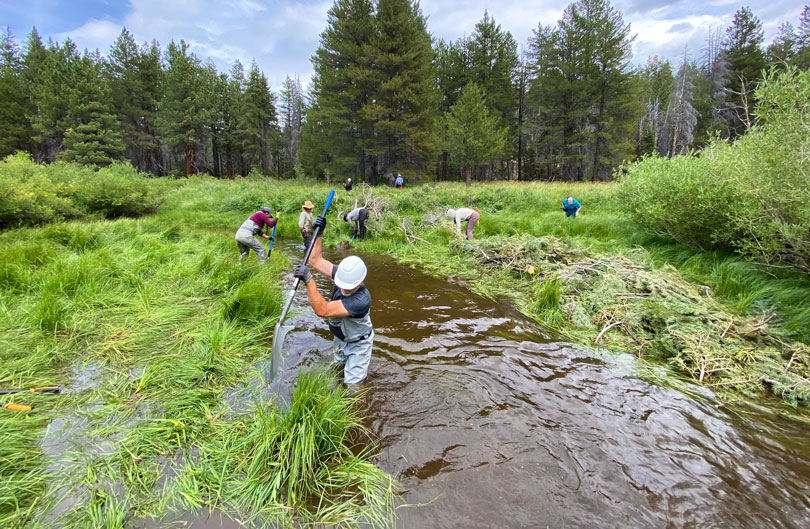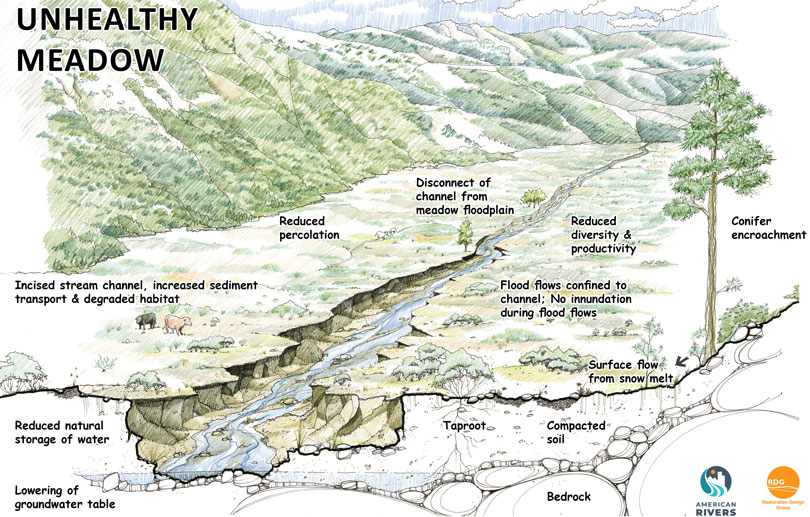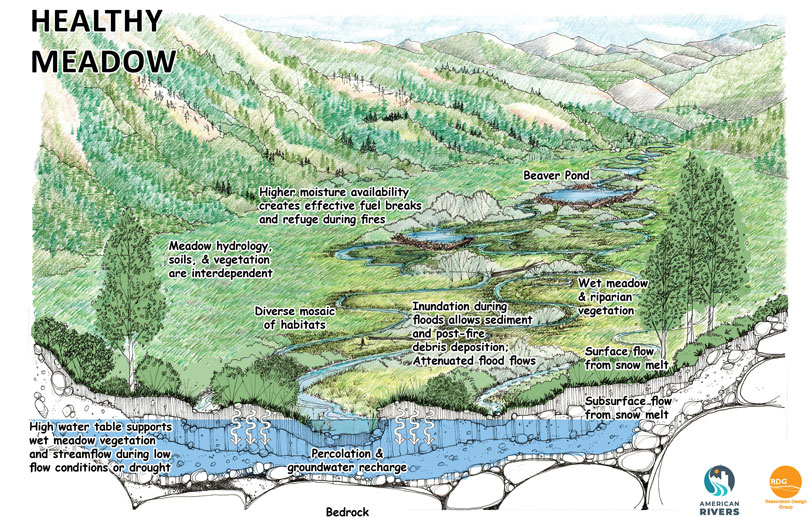
There’s a lot to love about meadows in the Sierra-Cascade region and recent momentum in restoration efforts means there could be a lot more meadows to love.
Currently, approximately 50 percent of known existing meadows are degraded or expected to be degraded and many more have already disappeared. The Sierra Nevada Conservancy (SNC) and its partners are working to restore these beloved ecosystems so that they can continue to provide essential services.
A recent study by the U.S. Forest Service’s Pacific Southwest Research Station found that meadows historically covered 3 times the amount of area as they do today. This is more than previously documented, raising the possibility that meadows could be restored across even more of the landscape.
What’s in a meadow?
Less than two percent of the Sierra-Cascade region is composed of meadows, yet their benefits should not be overlooked.


Water security
Acting as a natural sponge, meadows absorb and store water during spring runoff, preserving river flow during the dry summer months. In addition to beneficial runoff impacts, meadows also regulate water quality by removing excess pollution, nutrients, and sediment. Benefits of the natural water filter are seen at Tuolumne Meadows, one of the largest high-elevation meadows in the Sierra Nevada. Most of San Francisco’s tap water comes from the Tuolumne River via the Hetch Hetchy Reservoir, and because the water travels through the meadow, it is so clean the reservoir is one of just a few in the nation to require only minimal water treatment.
Carbon capture
Although meadows cover less than two percent of the Sierra-Cascade, research estimates that they contain 12 to 13 percent of total organic carbon soil stocks. While healthy meadows help retain the carbon in the soil and absorb greenhouse gases out of the atmosphere, degraded meadows emit the carbon stored.
Natural fire breaks
A healthy meadow’s wet condition and lack of trees create natural fire breaks, making the areas around them less prone to catastrophic wildfires.
Biodiversity hotspots
Hosting the highest levels of plant biodiversity of any habitat in the Sierra-Cascade, meadows are home to many rare and endangered plants. The unique plant communities make them excellent habitat for many California endemic species, including inland native trout, threatened and endangered birds (willow flycatcher, great grey owl, and greater sandhill crane), endangered amphibians (Yosemite toad, Sierra Nevada and mountain yellow-legged frogs, Cascade’s frog), native mammals (black bear, migratory deer herds, and bighorn sheep).
Meadow restoration efforts
Meadows have always been an integral part of the natural infrastructure of the Sierra-Cascade, historically yielding more water of higher quality. In recent decades, the SNC has supported numerous meadow restoration efforts including:
- West Fork Carson and Monitor Pass Project—Funded by the SNC and implemented by the National Forest Foundation in partnership with Humboldt-Toiyabe National Forest, the project’s 494 acres are enhancing and protecting the functions of a meadow in Hope Valley through the West Fork.
- Ackerson Meadow Restoration Project—Beginning with the SNC’s initial Strategic Land Conservation grant program, the acquisition of the meadow expanded Yosemite National Park by 400 acres. Now, with the collaborative partnership of American Rivers, National Park Service, Stanislaus National Forest, and the Yosemite Conservancy, the critical biodiversity hotspot and wildlife corridor is being restored.
The Sierra Meadows Partnership
To meet California’s ambitious 30×30 conservation and climate goals, it is important to increase the pace, scale, and efficacy of meadow restoration projects. The Sierra Meadows Partnership (SMP) aims to do just that with the goal of restoring and protecting 30,000 acres of meadows in the Sierra-Cascade by 2030.
Already the SMP has documented 71 projects that are restoring approximately 12,000 acres of meadows within the region between 2020–2022. To sustain the momentum, the California Wildlife Conservation Board awarded $24.7 million to the partnership in a groundbreaking block grant in November of 2022. So far in 2023, $10.6 million of the block grant has been distributed to projects spearheaded by members of the partnership, ensuring that more than 3,500 acres of meadow will be restored and an additional 1,800 acres will be ready for restoration in the near future.
Looking forward
There are many benefits of healthy meadows for landscapes and communities across California making them a poster child for multi-benefit, nature-based solutions. As California faces a host of challenges ranging from improving climate and wildfire resilience to water security and biodiversity conservation, restoring meadows across the Sierra-Cascade will remain a smart investment for California’s future.
